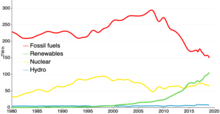Energy in the United Kingdom
Energy use in the United Kingdom stood at 2,249 TWh (193.4 million tonnes of oil equivalent) in 2014.[1] This equates to energy consumption per capita of 34.82 MWh (3.00 tonnes of oil equivalent) compared to a 2010 world average of 21.54 MWh (1.85 tonnes of oil equivalent).[2] Demand for electricity in 2014 was 34.42GW on average[3] (301.7TWh over the year) coming from a total electricity generation of 335.0TWh.[4]
Successive UK governments have outlined numerous commitments to reduce carbon dioxide emissions. One such announcement was the Low Carbon Transition Plan launched by the Brown ministry in July 2009, which aimed to generate 30% electricity from renewable sources, and 40% from low carbon content fuels by 2020. Notably, the UK is one of the best sites in Europe for wind energy, and wind power production is its fastest growing supply.[5][6][7] Wind power contributed 15% of UK electricity generation in 2017.[8]
Government commitments to reduce emissions are occurring against a backdrop of economic crisis across Europe.[9] During the European financial crisis, Europe's consumption of electricity shrank by 5%, with primary production also facing a noticeable decline. Britain's trade deficit was reduced by 8% due to substantial cuts in energy imports.[10] Between 2007 and 2015, the UK's peak electrical demand fell from 61.5 GW to 52.7.GW.[11][12]
UK government energy policy aims to play a key role in limiting greenhouse gas emissions, whilst meeting energy demand. Shifting availabilities of resources and development of technologies also change the country's energy mix through changes in costs. In 2018, the United Kingdom was ranked 6th in the World on the Environmental Performance Index,[13] which measures how well a country carries through environmental policy.

Overview
| Population million |
Prim. energy TWh |
Production TWh |
Import TWh |
Electricity TWh |
CO2-emission Mt | |
|---|---|---|---|---|---|---|
| 2004 | 59.8 | 2,718 | 2,619 | 135 | 371 | 537 |
| 2007 | 60.8 | 2,458 | 2,050 | 522 | 373 | 523 |
| 2008 | 61.4 | 2,424 | 1,939 | 672 | 372 | 511 |
| 2009 | 61.8 | 2,288 | 1,848 | 641 | 352 | 466 |
| 2010 | 62.2 | 2,355 | 1,730 | 705 | 357 | 484 |
| 2012 | 62.7 | 2,187 | 1,507 | 843 | 346 | 443 |
| 2012R | 63.7 | 2,236 | 1,366 | 1,011 | 347 | 457 |
| 2013 | 64.1 | 2,221 | 1,280 | 1,099 | 347 | 449 |
| 2014 | 64.6 | ? | ? | ? | 304 | 442 |
| 2015 | 65.1 | ? | ? | ? | 304 | 404 |
| 2016 | 65.7 | ? | 1,465 | ? | 304 | 381 |
| Change 2004-16 | 10% | ? | -44% | ? | -18% | -29% |
| Mtoe = 11.63 TWh>, Prim. energy includes energy losses that are 2/3 for nuclear power[15]
2012R = CO2 calculation criteria changed, numbers updated | ||||||
As recently as 2004, the UK was a net exporter of energy, however by 2010, more than 25% of UK energy was imported.
| Diesel | Gasoline | Natural gas | Coal | Electricity | ||
|---|---|---|---|---|---|---|
| per unit | litre | litre | m3 | MWh | tonne | MWh |
| Excise | ? | 0.4682 | ||||
| Environment | 1.93 | 15.12 | 5.54 | |||
Energy sources
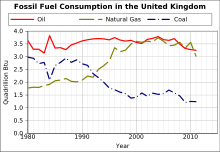
Oil
Concerns over peak oil production were raised by high-profile voices in the United Kingdom such as David King[17] and the Industry Task-Force on Peak Oil and Energy Security.[18] The latter's 2010 report states that "The next five years will see us face another crunch - the oil crunch. This time, we do have the chance to prepare. The challenge is to use that time well." (Richard Branson and Ian Marchant).[19]. However, peak oil was not reached and instead the debate is about when peak oil demand will be reached.[20]
Natural gas
United Kingdom produced 60% of its consumed natural gas in 2010. In five years the United Kingdom moved from almost gas self-sufficient (see North Sea gas) to 40% gas import in 2010. Gas was almost 40% of total primary energy supply (TPES) and electricity more than 45% in 2010. Underground storage was about 5% of annual demand and more than 10% of net imports. There is an alternative fuel obligation in the United Kingdom.[21] (see Renewable Transport Fuel Obligation)
Gasfields include Amethyst gasfield, Armada gasfield, Easington Catchment Area, East Knapton, Everest gasfield and Rhum gasfield.
A gas leak occurred in March 2012 at the Elgin-Franklin fields, where about 200,000 cubic metres of gas was escaping every day. Total missed out on about £83m of potential income.[22]
Coal
Coal power in England and Wales has reduced substantially in the beginning of the twenty-first century. The power stations known as the Hinton Heavies closed, and closure or conversion to biomass of the remaining coal plants is planned to complete by 2024.
Electricity production from coal in 2018 was less than any time since the industrial revolution, with the first "coal free day" in 2017 and the first coal free week in 2019.[23] Coal supplied 5.4% of UK electricity in 2018, down from 7% in 2017, 9% in 2016, 23% in 2015 and 30% in 2014.[24]
The UK Government announced in November 2015 that all the remaining fourteen coal-fired power stations would be closed by 2025.[25] In February 2020 the government said that it would consult on bringing the closure date forward to 2024.[26][27]
Nuclear
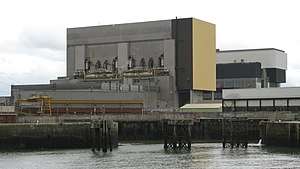
Britain's fleet of operational reactors consists of 14 advanced gas-cooled reactors at six discrete sites and one PWR unit at Sizewell B. The total installed nuclear capacity in the United Kingdom is about 9 GW.[28] In addition, the UK experimented with Fast Breeder reactor technologies at Dounreay in Scotland; however the last fast breeder (with 250MWe of capacity) was shut down in 1994.[29]
Even with changes to the planning system to speed nuclear power plant applications, there are doubts over whether the necessary timescale could be met to increase nuclear power output, and over the financial viability of nuclear power with present oil and gas prices. With no nuclear plants having been constructed since Sizewell B in 1995, there are also likely to be capacity issues within the native nuclear industry. The existing privatised nuclear supplier, British Energy, had been in financial trouble in 2004.
In October 2010 the coalition British Government gave the go-ahead for the construction of up to eight new nuclear power plants.[30] However, the Scottish Government, with the backing of the Scottish Parliament, has stated that no new nuclear power stations will be constructed in Scotland.[31][32]
Renewable energy
In 2007, the United Kingdom Government agreed to an overall European Union target of generating 20% of the European Union's energy supply from renewable sources by 2020. Each European Union member state was given its own allocated target; for the United Kingdom it is 15%. This was formalised in January 2009 with the passage of the EU Renewables Directive. As renewable heat and fuel production in the United Kingdom are at extremely low bases, RenewableUK estimates that this will require 35–40% of the United Kingdom's electricity to be generated from renewable sources by that date,[33] to be met largely by 33–35 GW of installed wind capacity.
In the third quarter of 2019, renewables contributed towards 38.9% of the UK's electricity generation, producing 28.8TWh of electricity.[34]
In June 2017 renewables plus nuclear generated more UK power than gas and coal together for the first time and new offshore wind power became cheaper than new nuclear power for the first time.[35]
Wind power

In December 2007, the United Kingdom Government announced plans for a massive expansion of wind energy production, by conducting a Strategic Environmental Assessment of up to 25 GW worth of wind farm offshore sites in preparation for a new round of development. These proposed sites were in addition to the 8 GW worth of sites already awarded in the 2 earlier rounds of site allocations, Round 1 in 2001 and Round 2 in 2003. Taken together it was estimated that this would result in the construction of over 7,000 offshore wind turbines.[36]
Wind power delivers a growing fraction of the energy in the United Kingdom and at the beginning of November 2018, wind power in the United Kingdom consisted of nearly 10,000 wind turbines with a total installed capacity of just over 20 gigawatts: 12,254 megawatts of onshore capacity and 7,897 megawatts of offshore capacity.[37]
Solar
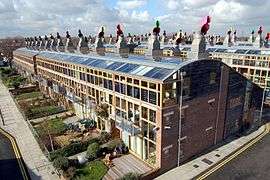
.jpg)
At the end of 2011, there were 230,000 solar power projects in the United Kingdom,[38] with a total installed generating capacity of 750 megawatts (MW).[39] By February 2012 the installed capacity had reached 1,000 MW.[40] Solar power use has increased very rapidly in recent years, albeit from a small base, as a result of reductions in the cost of photovoltaic (PV) panels, and the introduction of a Feed-in tariff (FIT) subsidy in April 2010.[38] In 2012, the government said that 4 million homes across the UK will be powered by the sun within eight years,[41] representing 22,000 MW of installed solar power capacity by 2020.[38]
Biofuels
Gas from sewage and landfill (biogas) has already been exploited in some areas. In 2004 it provided 129.3 GW·h (up 690% from 1990 levels), and was the UK's leading renewable energy source, representing 39.4% of all renewable energy produced (including hydro) in 2006.[42] The UK has committed to a target of 10.3% of renewable energy in transport to comply with the Renewable Energy Directive of the European Union but has not yet implemented legislation to meet this target.
Other biofuels can provide a close-to-carbon-neutral energy source, if locally grown. In South America and Asia, the production of biofuels for export has in some cases resulted in significant ecological damage, including the clearing of rainforest. In 2004 biofuels provided 105.9 GW·h, 38% of it wood. This represented an increase of 500% from 1990.[43]
The UK is importing large quantities of wood pellets from the United States, replacing coal at several generating stations.[44]
Geothermal power
Investigations into the exploitation of Geothermal power in the United Kingdom, prompted by the 1973 oil crisis, were abandoned as fuel prices fell. Only one scheme is operational, in Southampton. In 2004 it was announced that a further scheme would be built to heat the UK's first geothermal energy model village near Eastgate, County Durham.[45]
Hydroelectric

As of 2012, hydroelectric power stations in the United Kingdom accounted for 1.67 GW of installed electrical generating capacity, being 1.9% of the UK's total generating capacity and 14% of UK's renewable energy generating capacity. Annual electricity production from such schemes is approximately 5,700 GWh, being about 1.5% of the UK's total electricity production.[46]
There are also pumped-storage power stations in the UK. These power stations are net consumers of electrical energy however they contribute to balancing the grid, which can facilitate renewable generation elsewhere, for example by 'soaking up' surplus renewable output at off-peak times and release the energy when it is required.
Electricity sector
History
With the development of the national grid, the switch to using electricity, United Kingdom electricity consumption increased by around 150% between the post-war nationalisation of the industry in 1948 and the mid-1960s. During the 1960s growth slowed as the market became saturated. The United Kingdom is planning to reform its electricity market, see also Decarbonisation measures in proposed UK electricity market reform. It plans to introduce a capacity mechanism and contracts for difference to encourage the building of new generation.
During the 1940s some 90% of the electricity generation was by coal, with oil providing most of the remainder.
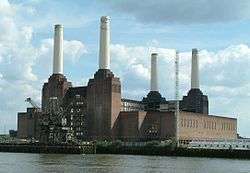
The United Kingdom started to develop nuclear power capacity in the 1950s, with Calder Hall nuclear power station being connected to the grid on 27 August 1956. Though the production of weapons-grade plutonium was the main reason behind this power station, other civil stations followed, and 26% of the nation's electricity was generated from nuclear power at its peak in 1997.
Despite the flow of North Sea oil from the mid-1970s, electricity generation from oil remained relatively small and continued to decline.
Starting in 1993, and continuing through the 1990s, a combination of factors led to a so-called Dash for Gas, during which the use of coal was scaled back in favour of gas-fuelled generation. This was sparked by the privatisation of the National Coal Board, British Gas and the Central Electricity Generating Board; the introduction of laws facilitating competition within the energy markets; and the availability of cheap gas from the North Sea. In 1990 just 1.09% of all gas consumed in the country was used in electricity generation; by 2004 the figure was 30.25%.[52]
By 2004, coal use in power stations had fallen to 50.5 million tonnes, representing 82.4% of all coal used in 2004 (a fall of 43.6% compared to 1980 levels), though up slightly from its low in 1999.[52] On several occasions in May 2016, Britain burned no coal for electricity for the first time since 1882.[53][54] On 21 April 2017, Britain went a full day without using coal power for the first time since the Industrial Revolution, according to the National Grid.[55]
From the mid-1990s new renewable energy sources began to contribute to the electricity generated, adding to a small hydroelectricity generating capacity.
Electricity generation
In 2016, total electricity production stood at 357 TWh (down from a peak of 385 TWh in 2005), generated from the following sources:[56][57]

- Gas: 40.2% (0.05% in 1990)
- Nuclear: 20.1% (19% in 1990)
- Wind: 10.6% (0% in 1990), of which:
- Onshore Wind: 5.7%
- Offshore Wind: 4.9%
- Coal: 8.6% (67% in 1990)
- Bio-Energy: 8.4% (0% in 1990)
- Solar: 2.8% (0% in 1990)
- Hydroelectric: 1.5% (2.6% in 1990)
- Oil and other: 7.8% (12% in 1990)
The UK energy policy had targeted a total contribution from renewable energy to achieve 10% by 2010, but it was not until 2012 that this figure was exceeded; renewable energy sources supplied 11.3% (41.3 TWh) of the electricity generated in the United Kingdom in 2012.[58] The Scottish Government had a target of generating 17% to 18% of Scotland's electricity from renewables by 2010,[59] rising to 40% by 2020.[60]
Regional differences
While in some ways limited by which powers are devolved, the four nations of the United Kingdom have different energy mixes and ambitions. Scotland currently has a target of 80% of electricity from renewables by 2020, which was increased from an original ambition of 50% by 2020 after it exceeded its interim target of 31 per cent by 2011.[61] Scotland has most of the UK's hydro-electric power generation facilities. It has a quarter of the EU's estimated offshore wind potential,[62] and is at the forefront of testing various marine energy systems.[63]
Cogeneration
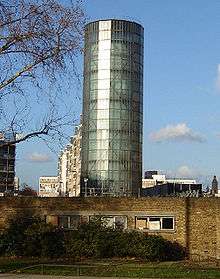
Combined heat and power (CHP) plants, where 'waste' hot water from generating is used for district heating, are also a well tried technology in other parts of Europe. While it heats about 50% of all houses in Denmark, Finland, Poland, Sweden and Slovakia, it currently only plays a small role in the United Kingdom. It has, however, been rising, with total generation standing at 27.9 TWh by 2008. This consisted of 1,439 predominantly gas-fired schemes with a total CHP electrical generating capacity of 5.47 GW, and contributing 7% of the UK's electricity supply.[47] Heat generation utilisation has fallen however from a peak of 65 TWh in 1991 to 49 TWh in 2012.
Energy research
Historically, public sector support for energy research and development in the United Kingdom has been provided by a variety of bodies with little co-ordination between them. Problems experienced have included poor continuity of funding, and the availability of funding for certain parts of the research—development—commercialisation process but not others. Levels of public funding have also been low by international standards, and funding by the private sector has also been limited.
Research in the area of energy is carried out by a number of public and private sector bodies:
The Engineering and Physical Sciences Research Council funds an energy programme[64] spanning energy and climate change research. It aims to "develop, embrace and exploit sustainable, low carbon and/or energy efficient technologies and systems" to enable the United Kingdom "to meet the Government’s energy and environmental targets by 2020". Its research includes renewable, conventional, nuclear and fusion electricity supply as well as energy efficiency, fuel poverty and other topics.
Since being established in 2004, the UK Energy Research Centre[65] carries out research into demand reduction, future sources of energy, infrastructure and supply, energy systems, sustainability and materials for advanced energy systems.
The Energy Technologies Institute, set up to 'accelerate the development of secure, reliable and cost-effective low-carbon energy technologies towards commercial deployment', began its work in 2007 and is due to close at the end of 2019.[66]
In relation to buildings, the Building Research Establishment[67] carries out some research into energy conservation.
There is currently international research being conducted into fusion power. The ITER reactor is currently being constructed at Cadarache in France. The United Kingdom contributed towards this project through membership of the European Union. Prior to this, an experimental fusion reactor (the Joint European Torus) had been built at Culham in Oxfordshire.
Energy efficiency
The United Kingdom government has instituted several policies intended to promote an increase in efficient energy use. These include the roll out of smart meters, the Green Deal, the CRC Energy Efficiency Scheme, the Energy Savings Opportunity Scheme[68] and Climate Change Agreements.
In tackling the energy trilemma, saving energy is the cheapest of all measures. The Guardian newspaper reported that in 2012 that by 2050, Germany projects a 25% drop in electricity demand: the UK projects a rise of up to 66%. MP and Secretary of State for Energy and Climate Change Ed Davey pointed out in November 2012 that a modest 10% reduction in 2030 means five fewer power stations and £4bn cut from bills.[69]
The UK government has implemented measures aimed at cutting the UK's energy use by 11% (around 196TWh) by 2020. If achieved, this improvement would be sufficient to replace 22 UK power stations, while possibly providing a boost to the economy and living standards.[70]
Climate change
The Committee on Climate Change publishes an annual progress report in respect to control the climate change in the United Kingdom.
Scotland cut greenhouse gas emissions by around 46% between 1990 and 2014.[71] Scotland aims to have a carbon-free electricity sector based on renewable energy sources by 2032. Scotland also aims to repair 250,000 hectares of degraded peatlands, which store a total of 1.7 gigatonnes of CO2.[72]
See also
- Compulsory Stock Obligation
- Energy policy of the United Kingdom
- Economy of the United Kingdom
- Energy conservation in the United Kingdom
- Energy switching services in the UK
- Greenhouse gas emissions by the United Kingdom
- Meter Point Administration Number
- Renewable energy by country
References
- "Energy consumption in the UK (2015);" (PDF). UK Department of Energy & Climate Change. Archived from the original (PDF) on 15 January 2016. Retrieved 26 December 2015.
- "Energy use (kg of oil equivalent per capita) | Data | Table". Data.worldbank.org. Retrieved 5 October 2013.
- "Gridwatch". Gridwatch. Retrieved 26 December 2015.
- "UK Energy Statistics, 2014 & Q4 2014" (PDF).
- UK Renewable Energy Roadmap Crown copyright, July 2011
- "BBC – Weather Centre – Climate Change – Wind Power". bbc.co.uk. Retrieved 9 June 2015.
- RenewableUK News website article Archived 9 May 2015 at the Wayback Machine
- "Record year for wind energy – Government releases official figures". 29 March 2018. Retrieved 18 April 2018.
- "World Energy Statistics | Energy Supply & Demand". Enerdata. Retrieved 5 October 2013.
- Energy Research Estore. "United Kingdom Energy Report, Enerdata 2012". Enerdata.net. Retrieved 5 October 2013.
- "Peak Light Bulb". New Scientist. 4 January 2014. p. 4.
- "UK Electricity production and demand 2015" (PDF). p. 124.
- "Data Explorer :: Table of Main Results | Environmental Performance Index". Epi.yale.edu. Archived from the original on 7 October 2013. Retrieved 5 October 2013.
- IEA Key World Energy Statistics Statistics 2015, 2014 (2012R as in November 2015 + 2012 as in March 2014 is comparable to previous years statistical calculation criteria, 2013, 2012, 2011, 2010, 2009 Archived 7 October 2013 at the Wayback Machine, 2006 Archived 12 October 2009 at the Wayback Machine IEA October, crude oil p.11, coal p. 13 gas p. 15
- Energy in Sweden 2010 Archived 16 October 2013 at the Wayback Machine, Facts and figures, The Swedish Energy Agency, Table 8 Losses in nuclear power stations Table 9 Nuclear power brutto
- Michel, Sharon (2015), Energy Prices And Taxes, Country Notes, 3rd Quarter 2015 (PDF), International Energy Agency, p. 118, archived from the original (PDF) on 19 January 2016
- Adam, David (9 June 2010). "Top scientist says politicians have 'heads in the sand' over oil". The Guardian. London.
- "Latest from the Taskforce | The Peak Oil Group". Peakoiltaskforce.net. 23 May 2011. Retrieved 5 October 2013.
- The Oil Crunch: A wake-up call for the UK economy, Second report of the UK Industry Taskforce on Peak Oil & Energy Security (ITPOES) February 2010
- https://www.forbes.com/sites/michaellynch/2018/06/29/what-ever-happened-to-peak-oil/#a866390731af
- Gas emergency policy: Where do IEA countries stand? IEA 25 May 2011, figures
- Elgin North Sea gas platform resumes production almost year after leak The Guardian 11 March 2013
- "UK has first coal-free week for a century". BBC News Online. 9 May 2019. Retrieved 19 May 2019.
- Evans, Simon (10 February 2016). "Countdown to 2025: Tracking the UK coal phase out". Carbon Brief. Retrieved 7 March 2016.
- Gosden, Emily (18 November 2015). "UK coal plants must close by 2025, Amber Rudd announces". The Independent. London. Retrieved 7 March 2016.
- "End of coal power to be brought forward in drive towards net zero". Gov UK. 4 February 2020. Retrieved 11 March 2020.
- https://www.current-news.co.uk/news/plans-to-bring-coal-phase-out-date-forward-to-2024-unveiled
- Nuclear capacity in the UK (PDF) (Report). gov.uk. 2017. Retrieved 15 January 2019.
- "Dounreay Site Restoration Ltd - Prototype Fast Reactor". Dounreay.com. 18 August 2008. Retrieved 5 October 2013.
- Eight new nuclear power stations despite safety and clean-up concerns Telegraph, published 2010-10-18, accessed 29 March 2011
- "Answers to your questions on energy in Scotland". The Scottish Government. Retrieved 5 May 2011.
- "Official Report 17 January 2008". The Scottish Parliament. Archived from the original on 20 June 2009. Retrieved 5 May 2011.
- McKenna, John (8 April 2009). "New Civil Engineer – Wind power: Chancellor urged to use budget to aid ailing developers". Nce.co.uk. Retrieved 5 October 2013.
- "UK Renewables Q3 2019" (PDF).
- "UK enjoyed 'greenest year for electricity ever' in 2017". BBC News. 28 December 2017. Retrieved 6 July 2018.
- Daley, Janet. "Earth". The Daily Telegraph. London.
- Association, RenewableUK. "Wind Energy Statistics - RenewableUK". www.renewableuk.com. Retrieved 31 October 2018.
- Yeganeh Torbati (9 February 2012). "UK wants sustained cuts to solar panel tariffs". Reuters.
- European Photovoltaic Industry Association (2012). "Market Report 2011". Archived from the original on 2 July 2014. Retrieved 26 April 2015.
- Jonathan Gifford (23 February 2012). "UK hits one GW of PV capacity". PV Magazine. Missing or empty
|url=(help) - Fiona Harvey (9 February 2012). "Greg Barker: 4m homes will be solar-powered by 2020".
- DTI figures Archived 9 December 2006 at the Wayback Machine
- (DTI figures) Archived 9 December 2006 at the Wayback Machine
- Beeler, Carolyn; Morrison, James (20 June 2018). "The UK's move away from coal means they're burning wood from the US". The World, PRI. Retrieved 16 July 2020.
- 'Hot rocks' found at cement plant
- "Department of Energy and Climate Change: UK use of Hydroelectricity". Archived from the original on 27 November 2012. Retrieved 23 September 2013.
- "Digest of UK energy statistics: 60th Anniversary Report". Retrieved 16 December 2013.
- Internation Energy Statistics
- "Archived copy" (PDF). Archived from the original (PDF) on 3 July 2016. Retrieved 14 August 2016.CS1 maint: archived copy as title (link)
- "Archived copy" (PDF). Archived from the original (PDF) on 8 October 2016. Retrieved 14 August 2016.CS1 maint: archived copy as title (link)
- https://www.gov.uk/government/statistics/electricity-section-5-energy-trends
- UK Energy in Brief July 2005, DTI statistics
- "Britain passes historic milestone with first days of coal-free power". Financial Times. Retrieved 19 June 2016.
- "Britain gets no power from coal for 'first time on record'". The Telegraph. 10 May 2016. Retrieved 19 June 2016.
- "First coal-free day in Britain since Industrial Revolution". BBC News. 22 April 2017. Retrieved 22 April 2017.
- "UK Energy Statistics, 2016" (PDF).
- "Digest of UK Energy Statistics - Department of Business, Energy & Industrial Strategy - GOV.UK". beis.gov.uk. Retrieved 24 October 2017.
- "Department of Energy and Climate Change: Annual tables: 'Digest of UK energy statistics' (DUKES) - Chapter 6: Renewable Sources of energy". Retrieved 1 September 2013.
- http://www.scotland.gov.uk/Resource/Doc/1050/0002275.pdf
- "Ministers confirm 40 per cent renewables target". Scotland.gov.uk. 25 March 2003. Retrieved 5 October 2013.
- "New target for Scottish renewable energy". BBC News. 23 September 2010.
- "New wind farm contracts announced". BBC News. 8 January 2010.
- Dutta, Kunal (17 March 2010). "Marine energy projects approved for Scotland". The Independent. London.
- Archived 25 September 2006 at the Wayback Machine, Engineering and Physical Sciences Research Council
- Archived 30 August 2006 at the Wayback Machine, UK Energy Research Centre
- Elliott, Dave (9 January 2019). "A swansong from the Energy Technologies Institute". Physics World. Retrieved 18 March 2019.
- Archived 25 September 2006 at the Wayback Machine, Building Research Establishment
- "ESOS: Energy Savings Opportunity Scheme". The Carbon Trust. Retrieved 9 July 2014.
- Energy saving finally gets serious as alarm bells wake ministers - Ed Davey has plugged a gaping hole in coalition energy policy by proposing serious if very belated - energy efficiency measures, but the overall policy remains a risky bet, The Guardian 29 November 2012
- Energy efficiency could replace 22 UK power stations Guardian 12 November 2012
- Scotland beats climate emissions reductions target six years early Guardian 16 June 2016
- Scotland sets ambitious goal of 66% emissions cut within 15 years Guardian 19 January 2017
External links
| Wikimedia Commons has media related to Energy in the United Kingdom. |
